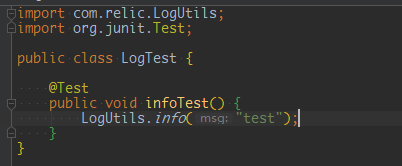平时项目中,我们一般会在每一个类中定义一个logger对象,一般是使用日志门面系统slf4j去获取日志对象
private static final Logger logger = LoggerFactory.getLogger(xx.class);但是考虑到项目文件如果非常之多,可能会非常麻烦,当然,可以使用lombok(这真是太好用了).还有一种方案就是自己定义一个Logger工具类,封装logger对象,但是这个弊端就是会使得打印位置信息的时候,全都定位到了这个工具类.
这里就提供一下比较常见的日志系统怎么来解决这个问题.害,空下来就光研究这些东西了.
log4j,公司的项目就是用的这个,very old,所以我今天就在琢磨想给他升级成logback/log4j2.
log4j自己的Logger对象有一个方法:public void log(String callerFQCN, Priority level, Object message, Throwable t)
这个方法可以将调用者的类名传入 FQCN (Full Qualified Class Name),然后在位置信息中有一段代码.
public LocationInfo(Throwable t, String fqnOfCallingClass) {
if(t == null || fqnOfCallingClass == null)
return;
if (getLineNumberMethod != null) {
try {
Object[] noArgs = null;
Object[] elements = (Object[]) getStackTraceMethod.invoke(t, noArgs);
String prevClass = NA;
for(int i = elements.length - 1; i >= 0; i--) {
String thisClass = (String) getClassNameMethod.invoke(elements[i], noArgs);
if(fqnOfCallingClass.equals(thisClass)) {
int caller = i + 1;
if (caller < elements.length) {
className = prevClass;
methodName = (String) getMethodNameMethod.invoke(elements[caller], noArgs);
fileName = (String) getFileNameMethod.invoke(elements[caller], noArgs);
if (fileName == null) {
fileName = NA;
}
int line = ((Integer) getLineNumberMethod.invoke(elements[caller], noArgs)).intValue();
if (line < 0) {
lineNumber = NA;
} else {
lineNumber = String.valueOf(line);
}
StringBuffer buf = new StringBuffer();
buf.append(className);
buf.append(".");
buf.append(methodName);
buf.append("(");
buf.append(fileName);
buf.append(":");
buf.append(lineNumber);
buf.append(")");
this.fullInfo = buf.toString();
}
return;
}
prevClass = thisClass;
}
return;
} catch(IllegalAccessException ex) {
LogLog.debug("LocationInfo failed using JDK 1.4 methods", ex);
} catch(InvocationTargetException ex) {
if (ex.getTargetException() instanceof InterruptedException
|| ex.getTargetException() instanceof InterruptedIOException) {
Thread.currentThread().interrupt();
}
LogLog.debug("LocationInfo failed using JDK 1.4 methods", ex);
} catch(RuntimeException ex) {
LogLog.debug("LocationInfo failed using JDK 1.4 methods", ex);
}
}
String s;
// Protect against multiple access to sw.
synchronized(sw) {
t.printStackTrace(pw);
s = sw.toString();
sw.getBuffer().setLength(0);
}
//System.out.println("s is ["+s+"].");
int ibegin, iend;
// Given the current structure of the package, the line
// containing "org.apache.log4j.Category." should be printed just
// before the caller.
// This method of searching may not be fastest but it's safer
// than counting the stack depth which is not guaranteed to be
// constant across JVM implementations.
ibegin = s.lastIndexOf(fqnOfCallingClass);
if(ibegin == -1)
return;
//
// if the next character after the class name exists
// but is not a period, see if the classname is
// followed by a period earlier in the trace.
// Minimizes mistakeningly matching on a class whose
// name is a substring of the desired class.
// See bug 44888.
if (ibegin + fqnOfCallingClass.length() < s.length() &&
s.charAt(ibegin + fqnOfCallingClass.length()) != '.') {
int i = s.lastIndexOf(fqnOfCallingClass + ".");
if (i != -1) {
ibegin = i;
}
}
ibegin = s.indexOf(Layout.LINE_SEP, ibegin);
if(ibegin == -1)
return;
ibegin+= Layout.LINE_SEP_LEN;
// determine end of line
iend = s.indexOf(Layout.LINE_SEP, ibegin);
if(iend == -1)
return;
// VA has a different stack trace format which doesn't
// need to skip the inital 'at'
if(!inVisualAge) {
// back up to first blank character
ibegin = s.lastIndexOf("at ", iend);
if(ibegin == -1)
return;
// Add 3 to skip "at ";
ibegin += 3;
}
// everything between is the requested stack item
this.fullInfo = s.substring(ibegin, iend);
}他会将传入的类名与调用者去进行比较,然后得到正确的位置信息.至此,所以我们只要使用org.apache.log4j.Logger对象的log方法,然后在pattern中使用%l/location就可以得到调用这个封装的日志方法的位置信息.
logback,spring boot 官方在用的日志框架,害,我也一直挺喜欢,因为spring boot里面 这个可以带颜色,花里胡哨,2333333.但今天去看了好多博客,发现的确好像性能是不如log4j2,但这里我也说一下.自己研究出来的比较蠢的替代方案吧.
因为logback是slf4j的一个实现方案,所以他自己已经封装好了FQCN信息,我无法去修改,但看了好久的文档(的确 英文水平不是特别过关哈).是有一个%caller,可以通过%caller得到调用栈.

但,其实我只需要得到调用者的调用者,也就是偏移了一位的caller ,那么就是使用%caller{1..2}这种方式,可以只得到Caller+1

但还不够,这也太难看了吧.用%replace正则替换
%replace(%replace(%caller{1..2}){'\w+\+\d+\s+at\s+',''}){'\s*',''}结果就是
[%-5level] %d{yyyy-MM-dd HH:mm:ss.SSS} [%thread] - %replace(%replace(%caller{1..2}){'\w+\+\d+\s+at\s+',''}){'\s*',''} %m%n
测试一下


得到了正确的位置信息.
Log4j2其实与Log4j差不多,但是我们需要取到Logger对象的具体实现类,在log4j.core里面的Logger对象,他有一个方法:
public void logIfEnabled(final String fqcn, final Level level, final Marker marker, final String message)
看到这个fqcn没有,直接传入工具类的class的名字.
最后他会在Log4jLogEvent里面的calcLocation方法中获取到调用者的信息.
public static StackTraceElement calcLocation(final String fqcnOfLogger) {
if (fqcnOfLogger == null) {
return null;
}
// LOG4J2-1029 new Throwable().getStackTrace is faster than Thread.currentThread().getStackTrace().
final StackTraceElement[] stackTrace = new Throwable().getStackTrace();
StackTraceElement last = null;
for (int i = stackTrace.length - 1; i > 0; i--) {
final String className = stackTrace[i].getClassName();
if (fqcnOfLogger.equals(className)) {
return last;
}
last = stackTrace[i];
}
return null;
}那么,在Pattern上用上%l/location,舒舒服服 简简单单,完成.